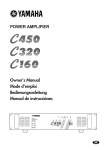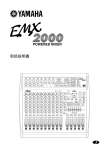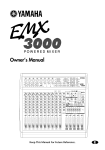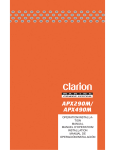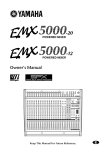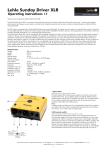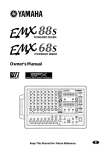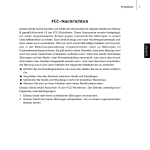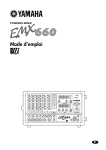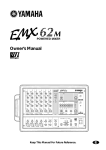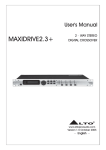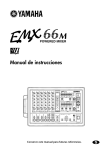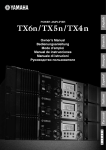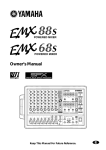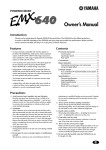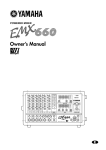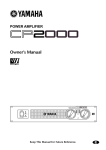Download Yamaha mix EMX 2000 Owner`s manual
Transcript
Owner’s Manual INPUT MIC MIC MIC OUTPUT MIC MIC MIC MIC MIC 9L B REC –10dBV TAPE 10 R LINE LINE LINE LINE LINE LINE LINE R 12 R B LINE 11 L L R ST 2 (MONO) (MONO) R ST SUB 1 R ST SUB 2 +4dB +4dB MONO +4dB +4dB MONI 1 L L (MONO) A R ST 1 +4dB R B 9L (MONO) A FOOT SW L L L 11 L B MONI 2 EFFECT +4dB +4dB INS I/O INS I/O INS I/O INS I/O 1 2 3 4 5 GAIN GAIN GAIN GAIN GAIN 0dB INSERT I/O OUT IN 10 R 12 R A 6 7 8 GAIN GAIN GAIN A 9/10 11/12 A B A B GAIN GAIN L R PAMP IN PHONES/ C-R OUT (+4dB) +4dB BRIDGE TAPE IN L POWER AMP R LIMITER PEAK +8 ST MONI 1 –34 +10 –34 PEAK HIGH 0 0 10 +15 MID –15 +15 MID –15 +15 MID –15 +15 MID –15 +15 MID –15 +15 MID –15 +15 MID –15 +15 MID –15 +15 MID –15 +15 MID 0 10 0 10 PHANTOM (+48V) 0 ST R MONO ON –1 OFF –3 MONO BRIDGE –5 MONI 2 MONI 1 ST +3 +4 +1 ST L MONI 1 MONI 2 PFL –15 +18 +18 +4 L/BRIDGE 10 POWER +5 LEVEL +10 –34 +10 –34 +10 –34 +10 –34 +10 –34 +10 –34 +10 –34 +10 –34 +10 –16 –16 –16 –16 –16 –16 –16 –16 –60 –60 –60 –60 –60 –60 –60 –60 PEAK PEAK PEAK PEAK PEAK PEAK PEAK PEAK PEAK HIGH HIGH HIGH HIGH HIGH HIGH HIGH HIGH HIGH EEEngine ST PHONES/C.R.OUT –7 –10 –15 +15 LOW –15 +15 LOW –15 +15 LOW –15 +15 LOW –15 +15 LOW –15 +15 LOW –15 +15 LOW –15 +15 LOW –15 +15 LOW –15 +15 0 10 0 10 0 –15 10 PFL L ON DIGITAL EFFECT –15 +15 MONI 1 –15 +15 MONI 1 –15 +15 MONI 1 –15 +15 MONI 1 –15 +15 MONI 1 –15 +15 MONI 1 –15 +15 MONI 1 –15 +15 MONI 1 –15 +15 MONI 1 0 –20 LOW –15 ST SUB 1 +15 MONI 1 MONI 1 6 7 8 9 5 4 3 0 MONI 2 10 0 MONI 2 10 0 MONI 2 10 0 MONI 2 10 0 MONI 2 10 0 MONI 2 10 0 MONI 2 10 0 MONI 2 10 0 MONI 2 10 0 MONI 2 10 0 EFFECT 10 0 EFFECT 10 0 EFFECT 10 0 EFFECT 10 0 EFFECT 10 0 EFFECT 10 0 EFFECT 10 0 EFFECT 10 0 EFFECT 10 0 EFFECT 10 0 MONI 2 10 2 1 16 15 PROGRAM 10 11 12 13 14 125 0 10 0 10 ST MIN 0 MAX 5 VOCAL REVERB 1 9 HALL 1 13 PLATE 1 2 VOCAL ECHO 2 6 VOCAL REVERB 2 10 HALL 2 14 PLATE 2 3 VOCAL ECHO 3 7 VOCAL REVERB 3 11 HALL 3 15 PLATE 3 8 VOCAL REVERB 4 12 ROOM 16 GATE REVERB 4 VOCAL ECHO 4 250 500 1k 2k 4k 8k +12 +12 6 0 10 PAN 0 10 PAN 0 10 PAN 0 10 PAN 0 10 PAN 0 10 PAN 0 10 PAN 0 10 PAN 0 10 BAL 0 10 BAL 10 1 VOCAL ECHO 1 6 0 10 ST 2 R ST1 0 6 6 –12 –12 ON PFL GRAPHIC EQUALIZER L L R PFL L R PFL L R PFL L R PFL L R PFL L R PFL L R PFL L R PFL L R PFL R ST SUB 2 PFL AFL AFL AFL AFL AFL 0 0 0 0 0 0 0 0 0 0 0 0 0 0 0 5 10 5 10 5 10 5 10 5 10 5 10 5 10 5 10 5 10 5 10 5 10 5 10 5 10 5 10 5 10 15 15 15 15 15 15 15 15 15 15 15 15 15 15 15 20 20 20 20 20 20 20 20 20 20 20 20 20 20 20 25 30 40 50 25 30 40 50 25 30 40 50 25 30 40 50 25 30 40 50 25 30 40 50 25 30 40 50 25 30 40 50 25 30 40 50 25 30 40 50 25 30 40 50 25 30 40 50 25 30 40 50 25 30 40 50 25 30 40 50 ∞ ∞ 1 ∞ 2 ∞ 3 ∞ 4 ∞ 5 ∞ 6 ∞ 7 ∞ 8 ∞ 9/10 ∞ 11/12 ∞ MONI 1 ∞ MONI 2 ∞ EFFECT ∞ ST 1 MONO E FCC INFORMATION (U.S.A.) 1. IMPORTANT NOTICE: DO NOT MODIFY THIS UNIT! This product, when installed as indicated in the instructions contained in this manual, meets FCC requirements. Modifications not expressly approved by Yamaha may void your authority, granted by the FCC, to use the product. 2. IMPORTANT: When connecting this product to accessories and/or another product use only high quality shielded cables. Cable/s supplied with this product MUST be used. Follow all installation instructions. Failure to follow instructions could void your FCC authorization to use this product in the USA. 3. NOTE: This product has been tested and found to comply with the requirements listed in FCC Regulations, Part 15 for Class “B” digital devices. Compliance with these requirements provides a reasonable level of assurance that your use of this product in a residential environment will not result in harmful interference with other electronic devices. This equipment generates/uses radio frequencies and, if not installed and used according to the instructions found in the users manual, may cause interference harmful to the operation of other electronic devices. Compliance with FCC regulations does not guarantee that interference will not occur in all installations. If this product is found to be the source of interference, which can be determined by turning the unit “OFF” and “ON”, please try to eliminate the problem by using one of the following measures: Relocate either this product or the device that is being affected by the interference. Utilize power outlets that are on different branch (circuit breaker or fuse) circuits or install AC line filter/s. In the case of radio or TV interference, relocate/reorient the antenna. If the antenna lead-in is 300 ohm ribbon lead, change the lead-in to coaxial type cable. If these corrective measures do not produce satisfactory results, please contact the local retailer authorized to distribute this type of product. If you can not locate the appropriate retailer, please contact Yamaha Corporation of America, Electronic Service Division, 6600 Orangethorpe Ave, Buena Park, CA 90620 This applies only to products distributed by YAMAHA CORPORATION OF AMERICA. WARNING: THIS APPARATUS MUST BE EARTHED IMPORTANT THE WIRES IN THIS MAINS LEAD ARE COLOURED IN ACCORDANCE WITH THE FOLLOWING CODE: GREEN-AND-YELLOW : EARTH BLUE : NEUTRAL BROWN : LIVE As the colours of the wires in the mains lead of this apparatus may not correspond with the coloured markings identifying the terminals in your plug, proceed as follows: The wire which is coloured GREEN and YELLOW must be connected to the terminal in the plug which is marked by the letter E or by the safety earth symbol or coloured GREEN and YELLOW. The wire which is coloured BLUE must be connected to the terminal which is marked with the letter N or coloured BLACK. The wire which is coloured BROWN must be connected to the terminal which is marked with the letter L or coloured RED. * This applies only to products distributed by YAMAHA KEMBLE MUSIC (U.K.) LTD. 2 Introduction Thank you for purchasing the Yamaha EMX2000 Powered Mixer. In order to take full advantage of the EMX2000 and enjoy long, trouble-free performance, please read this owner’s manual carefully, and keep it in a safe place for future reference. Features • The EMX2000 provides versatile inputs, such as two stereo input channels and two stereo sub inputs, as well as eight monaural input channels compatible with mic/line signals. The mixer also has ample power, with a maximum output of 200 W+200 W (400 W with bridge connection), and is suitable for a wide range of applications from installed systems to small-scale PA systems. • A two-channel power amp is built-in. The signals output to speakers can be selected as stereo main (ST L-R), monitor+monaural main (MONI 1MONO), or monaural main (bridge connection). – Stereo main The main stereo mix signal is output from speaker output jacks L and R of the EMX2000. You can connect one or two speakers to each speaker output jack. – Monitor+monaural main The main monaural mix signal is output from speaker output jack R, and the monitor signal from speaker output jack L. You can connect one or two speakers to each speaker output jack. – Monaural main (bridge connection) The two-channel power amp is bridge-connected, and the main monaural mix signal is output from BRIDGE jack. You can connect only one speaker for a much louder sound. EMX2000—Owner’s Manual • In addition to the speaker output jacks, two stereo output channels for line-level signals, two monitor output channels, one effect output, and one monaural output are provided. You can easily expand the system by adding a power amplifier or powered speakers. • The EMX2000 also has a PHONES C-R OUT jack, which is very useful for checking the sound. You can monitor only a specific channel or bus signal through the headphones. • Two limiter circuits are built-in to prevent excessive input levels to the amp. • A digital effect with sixteen selectable effect types is built-in. A variety of effects can be applied to add reverberation or ambience to vocals or instrumental sounds. • The EMX2000 has implemented “EEEngine”, Yamaha’s epochal amp drive technology to create an unrivaled high-efficiency drive. The EEEngine’s energy-saver/low-heat-generation design has reduced power consumption to 50% or less, and reduced heat generation to 35% or less (in field applications, compared to Yamaha’s previous models), and has lead to a reduction in energy cost and to less-restrictive installation requirements related to heat generation. 3 Precautions 1. Avoid excessive heat, humidity, dust and vibration Keep the unit away from locations where it is likely to be exposed to high temperatures or humidity — such as near radiators, stoves, etc. Also avoid locations which are subject to excessive dust accumulation or vibration which could cause mechanical damage. 2. Ventilation Allow a distance of 30 cm between the unit and the wall so that heat generated from the unit will be released effectively. Also, allow enough space between the unit and other devices. If you mount the unit in an audio rack, keep a space of 40 cm on the top panel, and a space of 15 cm to the side panel. Remove the rear panel of the rack or open a vent hole. If heat release is inadequate, the unit will retain heat inside the unit, which may cause a fire. 3. Avoid physical shocks Strong physical shocks to the unit can cause damage. Handle it with care. 4. Do not open the case or attempt repairs or modifications yourself This product contains no user-serviceable parts. Refer all maintenance to qualified Yamaha service personnel. Opening the case and/or tampering with the internal circuitry voids the warranty. 5. Always power off before making connections Always turn the power OFF before connecting or disconnecting cables. This is important to prevent damage to the unit itself as well as other connected equipment. 6. Handle cables carefully Always plug and unplug cables — including the AC power cord — by gripping the connector, not the cord. 7. Clean with a soft dry cloth Never use solvents such as benzine or thinner to clean the unit. Wipe clean with a soft, dry cloth. 8. Always use the correct power supply Make sure that the power supply voltage specified on the rear panel matches your local AC mains supply. Also make sure that the AC mains supply can deliver more than enough current to handle all equipment used in your system. 9. Do not touch the heatsink when the EMX2000 is in use. It can get very hot. Contents Front and rear panel................................ 4 Specifications......................................... 17 Control panel ...................................................4 General specifications.................................... 17 Input specifications ....................................... 18 Output specifications .................................... 18 Input/output panel.................................. 9 Rear panel.......................................................11 Connections........................................... 12 Connecting speakers......................................12 Connecting input/output equipment...........12 Dimensions............................................ 19 Block/Level Diagram............................. 20 Basic operation ...................................... 13 Connecting microphones and instruments .13 Using the digital effect ...................................13 Example setups ...................................... 14 As a band PA ..................................................14 As a conference/entertainment hall sound system .............................................................15 Using a subwoofer .........................................16 EMX2000—Owner’s Manual 4 Front and rear panel Control panel ■ Channel control section In this section, you can adjust equalization (frequency response), volume level, effect and monitor output levels for the input signal of each channel. 2 A B GAIN GAIN 1 3 +10 –34 –16 –60 PEAK HIGH –15 +15 MID 1 +10 –34 3 PEAK HIGH –15 4 –15 +15 LOW +15 LOW –15 +15 MONI 1 5 –15 –15 +15 0 MONI 2 10 0 MONI 2 10 0 EFFECT 10 0 EFFECT 10 6 PAN 0 10 BAL 7 8 L 9 0 5 6 10 L R PFL 0 5 10 5 10 15 15 20 20 25 30 40 50 25 30 40 50 ∞ R PFL 0 9 0 9/10 1 GAIN control Use this knob to adjust the sensitivity according to the input signal level, so that the input level is appropriate. For the best balance of S/N ratio and dynamic range, adjust this knob so that the peak indicator 3 lights occasionally. EMX2000—Owner’s Manual This is a 3-band equalizer that adjusts the high frequency range, mid frequency range, and low frequency range of each channel. Response is flat when the knobs are in the “▼” position. Rotating it toward the right will boost the corresponding frequency band, and rotating it toward the left will cut it. The base frequency (or center frequency), range of boost or cut, and equalizer type of each band are as follows: HIGH: 10kHz, ±15 dB, shelving type MID: 2.5kHz, ±15 dB, peaking type LOW: 100Hz, ±15 dB, shelving type 5 Monitor 1/2 controls (MONI 1/2) ∞ 1 The indicator will light 3 dB before clipping, warning that clipping level is near. 4 Equalizer controls (HIGH, MID, LOW) MONI 1 0 This switch selects channel 9/10~11/12 connectors. When the switch is up, the signal will be input from connectors A (phone jacks on the input/ output panel 3). When the switch is pressed in, the signal will be input from connectors B (phono jacks on the input/output panel 3). 3 PEAK indicator +15 MID 4 2 A/B switch (Channels 9/10~11/12 only) For each channel, this controls the amount of signal that is sent to the MONITOR 1/2 buses. The signal of the MONITOR 1 bus is sent to the MONI 1 jack (input/output panel 9). If the power amp select switch V is in the MONI 1MONO position, the signal is also sent to the speakers connected to the SPEAKERS L1/2 jacks. The signal of the MONITOR 2 bus is sent to the MONI 2 jack (input/output panel 9). Note: The signal sent to the MONITOR 1/2 buses does not pass through the channel fader 0 (pre-fader send). This means that it will not be affected by the setting of the channel fader. 5 6 Effect control (EFFECT) For each channel, this controls the amount of signal that is sent to the EFFECT bus. The signal of the EFFECT bus is sent to the EFFECT jack (input/output panel A). It is also sent to the built-in effect when the ON switch P in the EFFECT section is turned on. ■ Stereo sub input section In this section, you can adjust the input level of external equipment connected to the ST SUB 1/2 jacks on the input/output panel. MONI 1 A 0 Note: The amount of signal that is sent to the EFFECT bus from each channel will be affected not only by the setting of the EFFECT control, but also by the setting of the channel fader 0 (post-fader send). 7 PAN (panpot) control (Channels 1~8) The PAN knobs set the stereo position of the signal that is sent to the STEREO bus. 8 BAL (balance) control (Channels 9/10~ 11/12) The BAL knobs set the balance between the left and right channels, and assign the signals received at inputs 9/10~11/12 to the STEREO bus. 9 PFL (pre-fader listen) switch When the PFL switch is turned on, the signal of the corresponding channel at the point after the equalization but before the channel fader is sent to the PHONES/C-R OUT jack (input/output panel B). This is useful when you wish to listen to a particular channel through the headphones. Note: You can monitor the signal through the headphones even if the fader of the corresponding channel is set to the lowest level. The switch operation does not affect the signal sent to the STEREO bus, MONITOR 1/2 buses, or the EFFECT bus. 0 Channel fader This controls the output level of the input channel signal. 10 MONI 2 B 0 10 0 10 ST C D PFL ST SUB 1 MONI 1 A 0 MONI 2 10 B 0 10 0 10 ST C PFL D ST SUB 2 A MONI 1 (monitor 1) control The MONI 1 knob adjusts the amount of the signal sent from the ST SUB 1 and 2 jacks (input/ output panel 4) to the MONITOR 1 bus. B MONI 2 (monitor 2) control The MONI 2 knob adjusts the amount of the signal sent from the ST SUB 1 and 2 jacks to the MONITOR 2 bus. C ST (stereo) control The ST knob adjusts the amount of stereo signal sent from the ST SUB 1 and 2 jacks to the STEREO bus. Note: The ST control setting does not affect the level of the signal sent to the MONITOR 1/2 buses (pre-fader send). D PFL (pre-fader listen) switch When this switch is turned on, the signal at the point before the ST control knob C is sent to the PHONES/C-R OUT jack (input/output panel B). EMX2000—Owner’s Manual 6 ■ Master control section I MONO (monaural) fader In this section, you can adjust the final level of the outputs. AFL AFL AFL AFL AFL 0 0 0 0 0 5 10 5 10 5 10 5 10 5 10 15 15 15 15 15 20 20 20 20 20 25 30 40 50 25 30 40 50 25 30 40 50 25 30 40 50 25 30 40 50 ∞ ∞ ∞ ∞ J The MONO fader adjusts the final level of the monaural signal output from the STEREO bus to the MONO jack (input/output panel 0). If the Power amp select switch V is set to MONI 1-MONO, this fader also adjusts the level of the signal sent from the SPEAKERS R 1/2 jacks to the speakers. If the Power amp select switch V is set to MONO BRIDGE, this fader adjusts the level of the signal sent from the SPEAKERS BRIDGE jack to the speaker. J AFL (after fader listen) ∞ MONI 1 MONI 2 EFFECT ST 1 MONO E F G H I E MONI 1 (monitor 1) fader The MONI 1 fader adjusts the final level of the signal sent from the MONITOR 1 bus to the MONI 1 jack (input/output panel 9). If the Power amp select switch V is set to MONI 1MONO, using this fader enables you to adjust the level of the signal sent from the SPEAKER L 1/2 jacks to the speakers. F MONI 2 (monitor 2) fader The MONI 2 fader adjusts the final level of the signal output from the MONITOR 2 bus to the MONI 2 jack (input/output panel 9). When this switch is on, the output signal that passes through the corresponding fader is sent to the PHONES/C-R OUT jack (input/output panel B). Use these switches when you wish to monitor a particular output signal through the headphones. ■ Tape in section In this section, you can adjust the input level of a cassette deck or a CD player that is connected to the TAPE jacks (input/output panel 5). TAPE IN ST K 0 10 PFL L G EFFECT fader The EFFECT fader adjusts the final level of the signal output from the EFFECT bus to the EFFECT jack (input/output panel A). Note: The setting of this fader does not affect the level of the signal sent from the EFFECT bus to the built-in effect. H ST 1 (stereo 1) fader The ST 1 fader adjusts the final level of the signal sent from the STEREO bus to the ST 1 jacks (input/output panel 8). If the Power amp select switch V is set to ST L-ST R, this fader also adjusts the level of the signal sent to the SPEAKERS jacks (rear panel 1). Note: The setting of this fader does not affect the signal output from the STEREO bus to the ST 2 jacks. EMX2000—Owner’s Manual K ST (stereo) control This knob adjusts the level of the signal sent from the TAPE jacks to the STEREO bus. L PFL (pre-fader listen) switch When this switch is on, the signal input from the TAPE jacks is routed at the point before the ST control to the PHONES/C-R OUT jack (input/ output panel B). 7 ■ Digital effect section ■ Graphic equalizer section This section enables you to turn the built-in digital effect on/off and select the effect type. M MONI 1 10 125 N MONI 2 0 0 ST 10 0 10 ON DIGITAL EFFECT 6 7 8 9 5 4 3 2 1 16 15 PROGRAM 10 11 12 13 14 This section enables you to adjust the tone of the STEREO bus signal. MIN P Q 250 500 1k 2k 4k 8k +12 +12 6 6 0 0 6 6 –12 –12 R ON S GRAPHIC EQUALIZER MAX 1 VOCAL ECHO 1 5 VOCAL REVERB 1 9 HALL 1 13 PLATE 1 2 VOCAL ECHO 2 6 VOCAL REVERB 2 10 HALL 2 14 PLATE 2 3 VOCAL ECHO 3 7 VOCAL REVERB 3 11 HALL 3 15 PLATE 3 4 VOCAL ECHO 4 8 VOCAL REVERB 4 12 ROOM 16 GATE REVERB O M MONI 1/2 (monitor 1/2) control This knob adjusts the level of the return signal that is sent from the built-in digital effect to the MONITOR 1/2 buses. N ST (stereo) control This knob adjusts the level of the return signal that is sent from the built-in digital effect to the STEREO bus. O Effect selector This knob selects the effect type for the internal digital effect. P ON switch This switch turns the internal digital effect on/ off. Q Effect control This knob adjusts the time parameter of the internal digital effect. Note: The master EFFECT fader setting does not affect the internal digital effect signal. R Graphic equalizer This is a 7-band graphic equalizer that allows you to adjust the frequency response of the STEREO bus signal, providing a maximum of ±12 dB of cut/boost for each frequency band. This graphic equalizer affects both the STEREO bus signal that is output to the speakers and the line level signal that is output from the ST 1/2 jacks (input/output panel 8), and MONO jack (input/output panel 0). S ON switch This switch turns the graphic equalizer on/off. ■ Power amp section This section allows you to select the signals that will be input to the built-in two-channel power amplifier. L POWER AMP R LIMITER T U LEVEL +18 +4 L/BRIDGE +18 ST L MONI 1 +4 ST R MONO MONO BRIDGE V T LIMITER indicator This indicator lights up when the level of the signal output from the power amp section reaches the maximum and the limiter is activated. Adjust the LEVEL control U and appropriate fader so that the indicator lights up for only a short while when the signal reaches the maximum level. Note: The indicator lights up or flashes for a longer duration if the power amp section is significantly overloaded, which could result in malfunction. Avoid such a situation. EMX2000—Owner’s Manual 8 U LEVEL controls These knobs enable you to adjust the level of the signals input from the mixer section to the power amp section. Rotating the knob clockwise will raise the level of the input signal. Use a screwdriver of a width of 3mm or less to adjust the knob. If an external piece of equipment is connected to the P.AMP IN jacks (input/output panel 6), these knobs adjust the input sensitivity of the power amp (the input level that will provide the maximum output level in the power amp section). The sensitivity range is +18 dB~+4 dB, and rotating the knobs clockwise raises the input sensitivity. Note: If the Power amp select switch V is set to MONO BRIDGE, only the L/BRIDGE LEVEL control becomes effective. V Power amp select switch Select one of the following three settings to specify the signals to be routed to the corresponding jacks according to the speaker connection at the SPEAKER jacks 1 on the rear panel. • ST L-ST R The STEREO bus signals are output from the SPEAKERS L 1/2 jacks and the SPEAKERS R 1/2 jacks. The final level of these signals is adjusted by the master ST 1 fader. • MONI 1-MONO The MONITOR 1 bus signals are output from the SPEAKERS L 1/2 jacks, and a monaural signal that is a mix of the STEREO bus signals is output from the SPEAKERS R 1/2 jacks. The final level of these signals is adjusted by the master MONI 1 fader and the MONO fader. • MONO BRIDGE The monaural signal that is a mix of the STEREO bus is output from the BRIDGE jack. The final level of this signal is adjusted by the master MONO fader. Set the switch to this position when you connect only one speaker to play a loud sound. EMX2000—Owner’s Manual ■ Other indicators and controls X PEAK +8 POWER +5 +3 +1 W PHANTOM (+48V) 0 ON –1 OFF –3 –5 PHONES/C.R.OUT –7 Z –10 –15 0 –20 L Y 10 ST 2 [ R ST1 0 10 W Peak level indicator This indicator allows you to monitor the level of the signal output from the ST 1 jacks. The “0” indicator lights up when the ouput level reaches +4 dB. X POWER indicator This indicator will light up when the power of the EMX2000 is turned on. Y PHANTOM (+48V) switch and indicator This switch turns the phantom power supply on/ off for the MIC input jacks for channels 1~8. When this switch is on, the indicator lights up. Z PHONES/C.R.OUT (headphones/control room out) control This knob adjusts the level of the signal monitored via the PHONES/C-R OUT jack (input/ output panel B). [ ST 2 (stereo 2) control This knob adjusts the final level of the signal sent from the STEREO bus to the ST 2 jacks (input/ output panel 8). Note: The setting of this control does not affect signals that are sent from the STEREO bus to the ST 1 jacks and the SPEAKERS jacks. 9 Input/output panel 57 INPUT MIC MIC MIC OUTPUT MIC MIC MIC MIC MIC 9L B REC –10dBV TAPE 1 10 R 12 R B LINE LINE LINE INS I/O INS I/O INS I/O INS I/O 1 2 3 4 LINE LINE LINE LINE R 11 L (MONO) A (MONO) A 10 R 12 R L (MONO) L (MONO) R ST 1 +4dB L R B 9L FOOT SW L L L 11 L B LINE 8C 0 R ST 2 MONO +4dB +4dB MONI 1 MONI 2 5 OUT IN A 6 7 2 8 A 9/10 11/12 R R ST SUB 1 ST SUB 2 +4dB +4dB 3 L R PAMP IN BRIDGE 4 PHONES/ C-R OUT (+4dB) +4dB 6 A EFFECT +4dB +4dB 0dB INSERT I/O 9B 1 Channel input jacks (MIC, LINE) 1~8 These are the input jacks for channels 1~8. By using the GAIN control (control panel 1) you can connect any of the jacks to a wide range of sources, from mics to line-level devices (including synthesizers and rhythm machines). The MIC jacks can provide +48V phantom power, allowing you to use condenser microphones. Both MIC and LINE are balanced. They are compatible with microphones of output impedance 50~600Ω or line level devices of 600Ω. The nominal input level is –34 dB~+10 dB for the LINE jacks, and –60 dB~–16 dB for the MIC jacks. Pin connections for the MIC and LINE jacks are as follows: MIC jacks (XLR type) LINE jacks (TRS phone jacks) * Pin 1: ground Sleeve: ground Pin 2: hot (+) Tip: hot (+) Pin 3: cold (–) RIng: cold (–) Note: It is not possible to simultaneously use both the MIC and LINE inputs of a given channel. For each channel, use only one of the inputs as appropriate for the input source. Phantom power is switched on/off simultaneously for channels 1~8. For this reason, devices (in particular, unbalanced devices) other than condenser microphones must be connected to the LINE jacks of channels 1~8 or channel 9/10~11/12 input jacks if the PHANTOM +48V switch (control panel Y) is on. 2 INS I/O (insert) jacks 1~4 These are TRS phone jacks that enable you to insert an external effect processor, such as a compressor/limiter, between the equalizer and fader of input channels 1~4. These connections require a special “Y” cable, such as shown in the following diagram. The nominal input/output levels are 0 dB. to the input jack of the external processor * You can also connect a normal unbalanced phone plug. to the INS I/O jack Sleeve S + - GND Tip R T GND - + Sleeve Ring Tip to the output jack of the external processor EMX2000—Owner’s Manual 10 3 Channel input jacks 9~12A Channel input jacks 9~12B These are the input jacks for channels 9/10~11/12 and are used to connect to the stereo output jacks of electronic instruments, cassette decks, or CD players. Use the A/B switch (control panel 2) to select phone jacks (A) or phono jacks (B). The nominal input level –34 dB~+10 dB. Note: Use only the L phone (A) jacks to connect a monaural device that has phone jacks. 4 ST SUB 1 (stereo sub 1) jacks ST SUB 2 (stereo sub 2) jacks These phone jacks are used to connect stereo outputs of a sub mixer. The signal input here can be routed to the MONITOR 1 bus, MONITOR 2 bus, and STEREO bus. The nominal input level is +4 dB. Note: Use only the L jack to connect a monaural output device. 5 TAPE jacks These are input jacks that allow the signal from an external device, such as a tape deck and CD player, to be added to the STEREO bus. The nominal input level is –10 dBV. 6 P.AMP IN (power amp input) jacks These phone jacks are used to input line-level signals to the two-channel built-in power amplifier. Connect an external mixer output here. The nominal input level is +4 dB. Note: If you insert a plug into this jack, the corresponding channel of the power amplifier will be isolated, and no signals will be sent from the mixer section. Use the LEVEL control (control panel U) to adjust the level of the signal input to the power amplifier. 7 REC (record) jacks These phono jacks are used to connect to the inputs of a recording device, such as a tape deck, to record the signal from the STEREO bus. The nominal output level is –10 dBV. Note: The setting of the graphic equalizer or LEVEL control on the control panel does not affect the signals output from these jacks. Adjust the recording level on the recording device. EMX2000—Owner’s Manual 8 ST 1 (stereo 1) jacks ST 2 (stereo 2) jacks These phone jacks output the line-level signals of the STEREO bus. Connect an external mixer or additional PA system to these jacks. Use the ST 1 fader (control panel H) to adjust the final output level at the ST 1 jacks, and use the ST 2 control (control panel [) to adjust the final output level at the ST 2 jacks. The nominal output level is +4 dB. 9 MONI 1 (monitor 1) jack MONI 2 (monitor 2) jack These phone jacks output the line-level signals of the MONITOR 1/2 buses. Connect stage-monitoring amplifiers or powered speakers here. Use the MONI 1 fader (control panel E) and the MONI 2 fader (control panel F) respectively to adjust the final level of the signals output from these jacks. The nominal output level is +4 dB. 0 MONO (monaural) jack This phone jack mixes the STEREO bus signals and output a monaural signal. Connect an additional PA system here. Use the MONO fader (control panel I) to adjust the final level of the signal output from this jack. THe nominal output level is +4 dB. A EFFECT jack The input of an external effect unit such as a delay or echo can be connected to this jack. The signal adjusted by the EFFECT control of each channel will be sent to the EFFECT bus, its level adjusted by the EFFECT fader (control panel G), and output from this jack. The nominal output level is +4 dB. B PHONES/C-R OUT (headphones/control room out) jack This is a stereo phone type output jack, and is used to monitor the channels selected by the PFL switches on the front panel and the buses selected by the AFL switches. Connect the headphones here, or use a “Y” cable to connect to a monitor system. The nominal output is 3mW when headphones are connected, and +4 dB when a line-level device of a monitor system is connected. C FOOT SW (foot switch) jack A separately sold Yamaha FC5 foot switch can be connected to this jack so you can use your foot to switch the built-in digital effect on/off. The digital effect ON switch on the front panel must be set to ON in order to use a foot switch. 11 Rear panel 1 SPEAKERS R 2 1 BRIDGE L 2 1 POWER ON Caution: When using a bridge connection, do not connect anything to the SPEAKERS L or SPEAKERS R jacks. Likewise, when using the SPEAKERS L and/ or SPEAKERS R jacks, do not connect anything to the BRIDGE jack. OFF 2 1 SPEAKERS (speaker output) jacks Speakers can be connected to these jacks. The type of signals output, the number of speakers you can connect, and acceptable impedance differ depending on the setting of the Power amp select switch (control panel V). 2 POWER switch This switch turns on/off the power to the EMX2000. Note: Before turning on the power to the EMX2000, be sure to turn down the LEVEL control U on the control panel. • When the Power amp select switch is set to ST L-ST R or MONI 1-MONO: You can connect one or two speakers to each of the L and R jacks. When the Power amp select switch is set to ST LST R, the speakers connected to the L and R jacks will output the ST L and ST R bus signals. When the switch is set to MONI 1-MONO, the speakers will output the MONITOR L signal and the monaural signal respectively. Whichever way the switch is set to, connect 4~8Ω speakers if you use one speaker per channel. The maximum output is 200W+200W with two 4Ω speakers. If you wish to use two speakers per channel, use 8~16Ω speakers. The maximum output is 200W+200W with 8Ω impedance. • When the Power amp select switch is set to MONO BRIDGE: If you are connecting a single speaker to the BRIDGE jack, use a 8~16Ω speaker. The speaker outputs the MONO bus signal, and the maximum output is 400W with 8Ω impedance. If the signal output from the BRIDGE jack is the signal input to the P.AMP IN jack, be sure to input the signal to the P.AMP IN L jack. EMX2000—Owner’s Manual 12 Connections When connecting various devices, be sure to use cables and plugs of the appropriate standard. Connecting speakers There are three ways in which speakers can be connected to the EMX2000. 1 Connecting a single speaker to each of 3 BRIDGE connection: the L and R jacks: A single speaker each can be connected to either jack 1 or jack 2 of SPEAKERS L and of SPEAKERS R. A single speaker can be connected to the BRIDGE jack. For each of these, the required speaker impedance will differ. Refer to the following diagram, and make sure that the speaker impedance is not less than the specified value. 2 Connecting two speakers to each of the L and R jacks: Two speakers can be connected in parallel to both jack 1 and jack 2 of SPEAKERS L and SPEAKERS R. Connecting one speaker to each of the L/R jacks SPEAKERS R 2 1 Connecting two speakers to each of the L/R jacks L BRIDGE SPEAKERS R 2 1 2 1 Connecting a single speaker to the BRIDGE jack L BRIDGE 2 SPEAKERS R 1 2 1 BRIDGE 4Ω~8Ω 4Ω~8Ω 8Ω~16Ω 8Ω~16Ω 8Ω~16Ω Main speaker Main/monitor speaker Main speakers Main/monitor speakers Main speaker L 2 1 Connecting input/output equipment Foot switch Microphone Main speakers Cassette recorder CD player Power amplifier INPUT MIC MIC MIC OUTPUT MIC MIC MIC MIC MIC 9L B REC –10dBV TAPE 10 R LINE LINE LINE LINE LINE LINE LINE 9L (MONO) A INS I/O INS I/O INS I/O INS I/O 1 2 3 4 R 12 R B LINE (MONO) A L L (MONO) (MONO) R ST 1 +4dB L R B 11 L FOOT SW L L L 11 L B R ST 2 +4dB MONI 1 MONI 2 +4dB 0dB INSERT I/O 5 OUT IN 10 R A 6 7 8 9/10 12 R A 11/12 R ST SUB 1 R ST SUB 2 +4dB +4dB R L PAMP IN BRIDGE +4dB MONO +4dB EFFECT +4dB PHONES/ C-R OUT (+4dB) Headphones Synthesizer 88 Effect processor (compressor) Monitor speakers Drum machine 88 Effect processor (reverb) Additional/alternative PA system • An additional or alternative PA system can be connected to the ST 1/2, MONO, and MONI 1/2 jacks on the front panel. EMX2000—Owner’s Manual 13 Basic operation Connecting microphones and instruments 1 Before connecting mics or instruments, make sure that the power of all equipment (where applicable) is turned off. Also make sure that each channel fader and the faders in the master section are turned down. Check to see if the Power amp select switch on the control panel is set to ST L-ST R. 2 Connect cables to your mics and instrument, and insert the other end of the cables firmly into the appropriate MIC/ LINE jacks (channels 1~8) or the 9~12 jacks (channels 9/10~11/12). Note: You cannot use channel 1~8 MIC and LINE jacks at the same time. 3 Turn on the power to the peripheral devices, then turn on the power to the EMX2000. Note: When turning the power off, reverse this sequence. 4 While speaking into the mic (or while playing the instrument), adjust the channel GAIN control so that the channel PEAK indicator lights occasionally at the maximum volume. 5 Raise the ST1 fader in the master section to the “10” position, and while speaking into the mic (or while playing the instrument), adjust the channel fader so that the 0 LED of the peak level indicator lights occasionally. Use the LEVEL control to adjust the maximum level of the speakers. 6 If you wish to adjust the tone of each channel, rotate the equalizer controls as desired. 7 Use the graphic equalizer and the ST fader in the master section to adjust the overall volume and tone. Using the digital effect The EMX2000 has a built-in digital effect, allowing reverberation or ambiance to be added to vocals or instrumental sounds. 1 Connect a mic or instrument to the desired channels, and adjust the volume and tone. 2 Press the ON switch of the digital effect section. 3 Use the Effect selector to select the type of effect you wish to apply. VOCAL ECHO 1~4 ....... Echo appropriate for vocals. VOCAL REVERB 1~4.... Reverb appropriate for vocals. HALL 1~3............ Reverb typical of a large hall. ROOM ................. Reverb typical of a small room. PLATE 1~3 .......... Plate echo-like reverberation GATE REVERB ... Special effect of truncating reverberation 4 Raise the EFFECT control of the channels to which you wish to apply the digital effect. 5 Use the ST control of the digital effect section to adjust the level of the effect sound. Note: You can send the effect sound to the MONITOR 1/2 bus by raising the MONI 1/2 control in the digital effect section. If the effect sound is distorted even though the ST control and the MONI 1/2 controls in the digital effect section are turned all the way down, lower the EFFECT controls of the digital effect section. 6 Raise the EFFECT control of the digital effect section to the desired level. Note: The setting of the EFFECT fader in the master section does not affect the internal effect. Note: The volume level is affected by the settings of the channel equalizers and the graphic equalizer. When you set the equalizers, check the peak level indicator and adjust the ST fader if necessary. EMX2000—Owner’s Manual 14 Example setups This section provides some ways in which the EMX2000 can be used, and explains connections and operation. As a band PA Here is an example of using the EMX2000 as a small PA for a band. In this example, the monitor speakers are being sent a mix that is independent of the MAIN speaker mix. An external effect such as delay or reverb is also being used. ■ Connections • Connect mics or instruments, such as keyboards, to channel input jacks 1~8. • Connect the main speakers to the SPEAKERS R 1/2 jacks, and connect the monitor speakers to the SPEAKERS L 1/2 jacks. Set the Power amp select switch to “MONI 1-MONO.” • If you use an external effect such as delay or reverb, connect the EMX2000’s EFFECT jack to the input jack of the external effect, and connect the output jack of the external effect to the EMX2000’s ST SUB 1. Bass guitar Microphone Note: If you are using an external effect, we recommend that you turn down all the EFFECT controls of the digital effect section. You can connect the output of an external effect to channels 9/10 and 11/12 to apply the equalizer to the effect return signal. However in this case, make sure that the EFFECT controls are turned all the way down for the channels into which the effect sound is being input. If the EFFECT controls are raised, feedback will occur, and your speakers may be damaged. Guitar Keyboard * Direct box, effect unit, D.I.* pre-amp, etc. D.I.* INPUT MIC MIC MIC OUTPUT MIC MIC MIC MIC MIC 9L FOOT SW L L L 11 L B R ST 1 +4dB B TAPE 10 R B LINE LINE LINE LINE INS I/O INS I/O INS I/O INS I/O LINE 1 2 3 4 5 GAIN GAIN GAIN GAIN GAIN LINE LINE LINE L R 12 R R B 9L 11 L (MONO) A (MONO) A 10 R 12 R R ST 2 L MONO +4dB +4dB MONI 1 L (MONO) (MONO) MONI 2 88 EFFECT +4dB +4dB 0dB INSERT I/O OUT IN A 6 7 8 GAIN GAIN GAIN A 9/10 11/12 A B A B GAIN GAIN R R ST SUB 1 ST SUB 2 +4dB +4dB L R PAMP IN PHONES/ C-R OUT (+4dB) +4dB BRIDGE TAPE IN L POWER AMP R LIMITER –34 +10 –34 PEAK HIGH 0 +8 0 10 +18 +4 L/BRIDGE 10 PFL –15 +15 MID –15 +15 MID –15 +15 MID –15 +15 MID –15 +15 MID –15 +15 MID –15 +15 MID –15 +15 MID –15 +15 MID –15 +15 MID 0 10 0 10 +3 +4 +1 ST L MONI 1 MONI 2 POWER +5 +18 PHANTOM (+48V) 0 ST R MONO MONO BRIDGE –1 ON –3 OFF –5 MONI 2 MONI 1 ST ST +15 –15 +15 LOW –15 +15 LOW –15 +15 LOW –15 +15 LOW –15 +15 LOW –15 +15 LOW –15 +15 LOW –15 +15 LOW –15 +15 0 10 0 10 0 –15 10 PFL L ON DIGITAL EFFECT –15 +15 MONI 1 –15 +15 MONI 1 –15 +15 MONI 1 –15 +15 MONI 1 –15 +15 MONI 1 –15 +15 MONI 1 –15 +15 MONI 1 –15 +15 MONI 1 –15 +15 MONI 1 0 –20 LOW –15 ST SUB 1 +15 MONI 1 MONI 1 6 7 8 9 5 4 3 0 MONI 2 10 0 MONI 2 10 0 MONI 2 10 0 MONI 2 10 0 MONI 2 10 0 MONI 2 10 0 MONI 2 10 0 MONI 2 10 0 MONI 2 10 0 MONI 2 10 0 EFFECT 10 0 EFFECT 10 0 EFFECT 10 0 EFFECT 10 0 EFFECT 10 0 EFFECT 10 0 EFFECT 10 0 EFFECT 10 0 EFFECT 10 0 EFFECT 10 0 MONI 2 10 2 1 16 15 125 0 10 MIN R 0 MAX 5 VOCAL REVERB 1 9 HALL 1 13 PLATE 1 2 VOCAL ECHO 2 6 VOCAL REVERB 2 10 HALL 2 14 PLATE 2 3 VOCAL ECHO 3 7 VOCAL REVERB 3 11 HALL 3 15 PLATE 3 4 VOCAL ECHO 4 8 VOCAL REVERB 4 12 ROOM 16 GATE REVERB 250 500 1k 2k 4k 8k +12 6 6 0 0 0 10 PAN 0 10 PAN 0 10 PAN 0 10 PAN 0 10 PAN 0 10 PAN 0 10 PAN 0 10 PAN 0 10 BAL 0 10 0 10 BAL 6 6 –12 –12 ON PFL GRAPHIC EQUALIZER L L R PFL L R PFL L R PFL L R PFL L R PFL L R PFL L R PFL L R PFL L R PFL R ST SUB 2 PFL AFL AFL AFL AFL AFL 0 0 0 0 0 0 0 0 0 0 0 0 0 0 0 5 10 5 10 5 10 5 10 5 10 5 10 5 10 5 10 5 10 5 10 5 10 5 10 5 10 5 10 5 10 15 15 15 15 15 15 15 15 15 15 15 15 15 15 15 20 20 20 20 20 20 20 20 20 20 20 20 20 20 20 25 30 40 50 25 30 40 50 25 30 40 50 25 30 40 50 25 30 40 50 25 30 40 50 25 30 40 50 25 30 40 50 25 30 40 50 25 30 40 50 25 30 40 50 25 30 40 50 25 30 40 50 25 30 40 50 25 30 40 50 ∞ ∞ 1 ∞ 2 L1 ∞ 3 ∞ 4 ∞ 5 L2 ∞ 6 ∞ 7 ∞ 8 ∞ 9/10 ∞ 11/12 SPEAKERS jacks ∞ MONI 1 ∞ MONI 2 ∞ EFFECT R1 Monitor speakers Main speakers EMX2000—Owner’s Manual 10 1 VOCAL ECHO 1 +12 ST 10 ST 2 ST1 PROGRAM 10 11 12 13 14 ∞ ST 1 R2 MONO ST L MONI 1 ST R MONO MONO BRIDGE PHONES/C.R.OUT –7 –10 –15 LOW Effect processor PEAK ST MONI 1 LEVEL +10 –34 +10 –34 +10 –34 +10 –34 +10 –34 +10 –34 +10 –34 +10 –34 +10 –16 –16 –16 –16 –16 –16 –16 –16 –60 –60 –60 –60 –60 –60 –60 –60 PEAK PEAK PEAK PEAK PEAK PEAK PEAK PEAK PEAK HIGH HIGH HIGH HIGH HIGH HIGH HIGH HIGH HIGH EEEngine 15 As a conference/entertainment hall sound system Here is an example of using the EMX2000 as a conference or entertainment hall sound system. Cassette recorder (for recording) Cassette recorder (for paly back) Microphone CD player Effect processor 88 INPUT MIC MIC MIC OUTPUT MIC MIC MIC MIC MIC 9L FOOT SW L L L 11 L B R ST 1 +4dB B TAPE 10 R LINE LINE LINE INS I/O INS I/O INS I/O INS I/O LINE 1 2 3 4 5 GAIN GAIN GAIN GAIN GAIN LINE LINE LINE R 12 R B LINE L R B 9L 11 L (MONO) A L (MONO) A R ST 2 MONO +4dB +4dB MONI 1 L (MONO) (MONO) MONI 2 EFFECT +4dB +4dB 0dB INSERT I/O OUT IN 10 R 12 R A 6 7 8 GAIN GAIN GAIN A 9/10 11/12 A B A B GAIN GAIN R ST SUB 1 R ST SUB 2 +4dB +4dB L R PAMP IN PHONES/ C-R OUT (+4dB) +4dB BRIDGE TAPE IN L POWER AMP R LIMITER PEAK +8 ST MONI 1 –34 +10 –34 PEAK HIGH 0 0 10 +18 +4 L/BRIDGE 10 PFL –15 +15 MID –15 +15 MID –15 +15 MID –15 +15 MID –15 +15 MID –15 +15 MID –15 +15 MID –15 +15 MID –15 +15 MID –15 +15 MID 0 10 0 10 +3 +4 +1 PHANTOM (+48V) 0 ST R MONO MONO BRIDGE –1 ON –3 OFF –5 MONI 2 MONI 1 ST +18 ST L MONI 1 MONI 2 POWER +5 LEVEL +10 –34 +10 –34 +10 –34 +10 –34 +10 –34 +10 –34 +10 –34 +10 –34 +10 –16 –16 –16 –16 –16 –16 –16 –16 –60 –60 –60 –60 –60 –60 –60 –60 PEAK PEAK PEAK PEAK PEAK PEAK PEAK PEAK PEAK HIGH HIGH HIGH HIGH HIGH HIGH HIGH HIGH HIGH EEEngine ST ST L MONI 1 ST R MONO MONO BRIDGE PHONES/C.R.OUT –7 –10 –15 +15 LOW –15 +15 LOW –15 +15 LOW –15 +15 LOW –15 +15 LOW –15 +15 LOW –15 +15 LOW –15 +15 LOW –15 +15 LOW –15 +15 0 10 0 10 0 –15 10 PFL L ON DIGITAL EFFECT –15 +15 MONI 1 –15 +15 MONI 1 –15 +15 MONI 1 –15 +15 MONI 1 –15 +15 MONI 1 –15 +15 MONI 1 –15 +15 MONI 1 –15 +15 MONI 1 –15 +15 MONI 1 0 –20 LOW –15 ST SUB 1 +15 MONI 1 MONI 1 6 7 8 9 5 4 3 0 MONI 2 10 0 MONI 2 10 0 MONI 2 10 0 MONI 2 10 0 MONI 2 10 0 MONI 2 10 0 MONI 2 10 0 MONI 2 10 0 MONI 2 10 0 MONI 2 10 0 EFFECT 10 0 EFFECT 10 0 EFFECT 10 0 EFFECT 10 0 EFFECT 10 0 EFFECT 10 0 EFFECT 10 0 EFFECT 10 0 EFFECT 10 0 EFFECT 10 0 MONI 2 10 2 1 16 15 PROGRAM 10 11 12 13 14 125 0 10 ST MIN 0 MAX 5 VOCAL REVERB 1 9 HALL 1 13 PLATE 1 2 VOCAL ECHO 2 6 VOCAL REVERB 2 10 HALL 2 14 PLATE 2 3 VOCAL ECHO 3 7 VOCAL REVERB 3 11 HALL 3 15 PLATE 3 4 VOCAL ECHO 4 8 VOCAL REVERB 4 12 ROOM 16 GATE REVERB 250 500 1k 2k 4k 8k +12 +12 6 0 0 10 0 10 PAN 0 10 PAN 0 10 PAN 0 10 PAN 0 10 PAN 0 10 PAN 0 10 PAN 0 10 BAL 0 10 0 10 BAL 10 1 VOCAL ECHO 1 6 PAN 10 ST 2 R ST1 0 6 6 –12 –12 ON PFL GRAPHIC EQUALIZER L L R PFL L R PFL L R PFL L R PFL L R PFL L R PFL L R PFL L R PFL L R PFL R ST SUB 2 PFL AFL AFL AFL AFL AFL 0 0 0 0 0 0 0 0 0 0 0 0 0 0 0 5 10 5 10 5 10 5 10 5 10 5 10 5 10 5 10 5 10 5 10 5 10 5 10 5 10 5 10 5 10 15 15 15 15 15 15 15 15 15 15 15 15 15 15 15 20 20 20 20 20 20 20 20 20 20 20 20 20 20 20 25 30 40 50 25 30 40 50 25 30 40 50 25 30 40 50 25 30 40 50 25 30 40 50 25 30 40 50 25 30 40 50 25 30 40 50 25 30 40 50 25 30 40 50 25 30 40 50 25 30 40 50 25 30 40 50 25 30 40 50 ∞ ∞ 1 ∞ 2 L2 ∞ 3 ∞ 4 ∞ 5 ∞ 6 L1 ∞ 7 ∞ 8 ∞ 9/10 ∞ 11/12 SPEAKERS jacks ∞ MONI 1 R1 ∞ MONI 2 ∞ EFFECT ∞ ST 1 MONO R2 Main speakers ■ Connections • Connect mics to channel inputs 1~8. • A CD player/LD player/cassette deck can also be connected to the input jacks of channels 9/10 and 11/12. • To record a meeting or a party, connect the REC jacks of the EMX2000 to the input jack of a recording cassette deck, and to monitor the recording on the EMX2000, connect the TAPE jacks of the EMX2000 to the output of the recording cassette deck. ■ Playing back a CD player 1 Turn on the power to the peripheral devices, then to the EMX2000. 2 Start playback on the CD player. Use the GAIN control of channel 9/10 so that the PEAK indicator below the GAIN control will light occasionally. Then, raise the ST 1 fader to the “10” position, and adjust the channel 9/10 fader so that the 0 LED of the peak indicator will light occasionally. • Connect the main speakers to the SPEAKERS L 1/2 jacks and the SPEAKERS R 1/2 jacks, and set the Power amp select switch to ST L-ST R. EMX2000—Owner’s Manual 16 ■ Sending an independent mix to the monitor speakers ■ Using an external effect processor You may sometimes want to use an external effect processor, such as an echo machine or a multieffect unit. In this case, refer to the diagram on page 13 for connection information and follow the steps below. 1 Set the MONI 1 or MONI 2 fader to the “10” position. 2 Raise the MONI 1 or MONI 2 controls for the channels that you wish to hear from the monitor speakers. 1 Set the EFFECT fader of the master section to the “10” position. Note: The MONI controls are not affected by the level settings of each channel. This allows you to create a mix that is independent of the main speakers. 2 Raise the EFFECT controls for the channels 3 Use the MONI 1 or MONI 2 fader of the tion to adjust the level of the signal output to the external effects processor so that the sound will not be distorted at the input of the external effects processor. to which you want the external effect to be applied. 3 Use the EFFECT fader in the master sec- master section to adjust the overall volume. 4 Use the control of the ST SUB channel to which the processed signal is input from the external effects processor to adjust the level of the effect sound. Using a subwoofer Here is an example of using a subwoofer in the speaker system. Yamaha Crossover network PN90 INPUT MIC MIC MIC OUTPUT MIC MIC MIC MIC MIC 9L L L L 11 L B LEFT INPUTS RIGHT FOOT SW R ST 1 +4dB B TAPE 10 R LINE LINE LINE LINE INS I/O INS I/O INS I/O INS I/O LINE LINE LINE LINE L R 12 R B 9L 11 L R ST 2 R B L (MONO) A (MONO) (MONO) 10 R 12 R R ST SUB 1 R ST SUB 2 MONI 1 +4dB +4dB MONI 2 1 2 3 4 5 GAIN GAIN GAIN GAIN GAIN OUT IN 6 7 8 GAIN GAIN GAIN A 9/10 11/12 A B R P.AMP IN TAPE IN GAIN PHONES/ C-R OUT (+4dB) +4dB BRIDGE A B GAIN L L POWER AMP R LIMITER –34 +10 –34 PEAK HIGH 0 +8 0 10 +18 +4 L/BRIDGE 10 –15 +15 –15 +15 MID –15 +15 MID –15 +15 MID –15 +15 MID –15 +15 MID –15 +15 MID –15 +15 MID –15 +15 MID –15 +15 MID 0 10 0 10 +3 +4 +1 PHANTOM (+48V) 0 ST R MONO MONO BRIDGE –1 ON –3 OFF –5 MONI 2 MONI 1 ST POWER +5 +18 ST L MONI 1 MONI 2 PFL MID EEEngine PEAK ST MONI 1 LEVEL +10 –34 +10 –34 +10 –34 +10 –34 +10 –34 +10 –34 +10 –34 +10 –34 +10 –16 –16 –16 –16 –16 –16 –16 –16 –60 –60 –60 –60 –60 –60 –60 –60 PEAK PEAK PEAK PEAK PEAK PEAK PEAK PEAK PEAK HIGH HIGH HIGH HIGH HIGH HIGH HIGH HIGH HIGH LOW LEFT RIGHT EFFECT +4dB +4dB A HIGH LEFT RIGHT MONO +4dB +4dB L (MONO) A 0dB INSERT I/O TO POWER AMP INPUTS ST ST L MONI 1 ST R MONO MONO BRIDGE PHONES/C.R.OUT –7 –10 –15 +15 LOW –15 +15 LOW –15 +15 LOW –15 +15 LOW –15 +15 LOW –15 +15 LOW –15 +15 LOW –15 +15 LOW –15 +15 LOW –15 +15 0 10 0 10 0 –15 10 PFL L ON DIGITAL EFFECT –15 +15 MONI 1 –15 +15 MONI 1 –15 +15 MONI 1 –15 +15 MONI 1 –15 +15 MONI 1 –15 +15 MONI 1 –15 +15 MONI 1 –15 +15 MONI 1 –15 +15 MONI 1 0 –20 LOW –15 ST SUB 1 +15 MONI 1 MONI 1 6 7 8 9 5 4 3 0 MONI 2 10 0 MONI 2 10 0 MONI 2 10 0 MONI 2 10 0 MONI 2 10 0 MONI 2 10 0 MONI 2 10 0 MONI 2 10 0 MONI 2 10 0 MONI 2 10 0 EFFECT 10 0 EFFECT 10 0 EFFECT 10 0 EFFECT 10 0 EFFECT 10 0 EFFECT 10 0 EFFECT 10 0 EFFECT 10 0 EFFECT 10 0 EFFECT 10 0 MONI 2 10 2 1 16 15 125 0 10 0 10 ST R ST1 PROGRAM 10 11 12 13 14 MIN 0 MAX 5 VOCAL REVERB 1 9 HALL 1 13 PLATE 1 2 VOCAL ECHO 2 6 VOCAL REVERB 2 10 HALL 2 14 PLATE 2 3 VOCAL ECHO 3 7 VOCAL REVERB 3 11 HALL 3 15 PLATE 3 4 VOCAL ECHO 4 8 VOCAL REVERB 4 12 ROOM 16 GATE REVERB 250 500 1k 2k 4k 0 10 PAN 0 10 PAN 0 10 PAN 0 10 PAN 0 10 PAN 0 10 PAN 0 10 PAN 0 10 BAL 0 10 BAL Power AMP 8k +12 +12 6 0 10 10 1 VOCAL ECHO 1 6 0 PAN 10 ST 2 0 6 6 –12 –12 ON PFL GRAPHIC EQUALIZER L L R PFL L R PFL L R PFL L R PFL L R PFL L R PFL L R PFL L R PFL L R PFL R ST SUB 2 PFL AFL AFL AFL AFL AFL 0 0 0 0 0 0 0 0 0 0 0 0 0 0 0 5 10 5 10 5 10 5 10 5 10 5 10 5 10 5 10 5 10 5 10 5 10 5 10 5 10 5 10 5 10 15 15 15 15 15 15 15 15 15 15 15 15 15 15 15 20 20 20 20 20 20 20 20 20 20 20 20 20 20 20 25 30 40 50 25 30 40 50 25 30 40 50 25 30 40 50 25 30 40 50 25 30 40 50 25 30 40 50 25 30 40 50 25 30 40 50 25 30 40 50 25 30 40 50 25 30 40 50 25 30 40 50 25 30 40 50 25 30 40 50 ∞ ∞ 1 ∞ 2 ∞ 3 ∞ 4 ∞ 5 ∞ 6 ∞ 7 ∞ 8 ∞ 9/10 ∞ 11/12 ∞ MONI 1 ∞ MONI 2 ∞ EFFECT ∞ ST 1 MONO Subwoofer L 1/2 SPEAKERS jacks Main speakers EMX2000—Owner’s Manual R 1/2 17 Specifications ■ General specifications Maximum output power Frequency response Total harmonic distortion STEREO: 200 W+200 W/4Ω @0.5% THD at 1 kHz BRIDGE: 400 W/8Ω @0.5% THD at 1 kHz 20 Hz~20 kHz +1 dB, –3 dB @1 W output into 8Ω (SPEAKER OUT) All channel Gain controls at minimum. 20 Hz~20 kHz +1 dB, –3 dB @+4 dB output into 600Ω (ST OUT, MONO OUT, EFFECT SEND, MONITOR OUT) All channel Gain controls at minimum. Less than 0.5% @20 Hz~20 kHz, 100 W output into 4Ω (SPEAKER OUT) Less than 0.3% @20 Hz~20 kHz, +14 dB output into 600Ω (ST OUT, MONO OUT, EFFECT SEND, MONITOR OUT) –128 dB equivalent input noise –63 dB residual output noise (SPEAKER OUT) –95 dB residual output noise (ST OUT, MONO OUT, EFFECT SEND, MONITOR OUT) Hum & noise (Average, Rs=150Ω) (with 20 Hz~20 kHz BPF) –87 dB (ST OUT, MONO OUT) ST master/MONO master fader at maximum level and all channel fader at minimum. –64 dB (68 dB S/N) (ST OUT, MONO OUT) ST master/MONO master fader and 1 channel fader at maximum level. And 1 channel Gain control at maximum. –80 dB (EFFECT SEND, MONITOR OUT) Master fader at maximum level and all channel level controls at minimum. Maximum voltage gain 91 dB 64 dB 38 dB 38 dB 70 dB 64 dB MIC IN to SPEAKER OUT MIC IN to ST OUT LINE IN to ST OUT ST IN to ST OUT MIC IN to EFFECT SEND MIC IN to MONITOR OUT (CH 1~8) (CH 1~8) (CH 1~8) (CH 9/10, 11/12) (CH 1~8) (CH 1~8) Crosstalk at 1 kHz –70 dB adjacent input, –70 dB input to output MIC IN gain control 44 dB variable Input channel equalization HIGH 10 kHz shelving* MID 2.5 kHz peaking LOW 100 Hz shelving* * Turn over/roll off frequency of shelving: 3 dB below maximum variable level. Meters 13 points LED meter CH peak indicators Red LED on each channel lits when POST EQ signal reaches the level –3 dB below clipping. Limiter Comp. : THD≥0.5% LIMIT indicators Lit when THD≥0.5% Graphic equalizer 7 bands (125, 250, 500, 1k, 2k, 4k, 8k Hz), ±12 dB Maximum Internal digital effect 16 programs Foot switch Digital effect mute: on/off Phantom power +48 V is supplied to electrically balanced inputs. Option FC5 Power requirement USA and Canada Europe Other Power consumption 210 W Dimensions (WxHxD) 480×125×454 mm Weight 14 kg 120 V AC 60 Hz 240 V AC 50 Hz 230 V AC 50 Hz EMX2000—Owner’s Manual 18 ■ Input specifications Gain trim Actual load impedance For use with nominal MIC INPUT (1–8) MAX MIN 5 kΩ LINE INPUT (1–8) MAX MIN ST INPUT (9–12) MAX MIN Input terminals Input level Connectors on mixer Sensitivity1 Max. before clip 50~600Ω Mics –60 dB (775 µV) –16 dB (123 mV) –40 dB (7.75 mV) +4 dB (1.23 V) XLR-3-31 type2 50 kΩ 600Ω Lines –34 dB (15.5 mV) +10 dB (2.45 V) –14 dB (155 mV) +30 dB (24.5 V) PHONE JACK (TRS)2 10 kΩ 600Ω Lines –34 dB (15.5 mV) +10 dB (2.45 V) –14 dB (155 mV) +30 dB (24.5 V) PHONE JACK3 ST SUB IN (1, 2) 10 kΩ 600Ω Lines +4 dB (1.23 V) +20 dB (7.75 V) TAPE IN (L, R) 10 kΩ 600Ω Lines –10 dBV (316 mV) +10 dBV (3.16 V) CH INSERT IN (1–4) 10 kΩ 600Ω Lines 0 dB (775 mV) +20 dB (7.75 V) PHONE JACK (I/O)3 POWER AMP IN (L, R) 10 kΩ 600Ω Lines +4 dB (1.23 V) +18 dB (6.16 V) PHONE JACK3 1. 2. 3. • PHONO JACK Sensitivity is the lowest level that can produce an output of +4 dB (1.23 V) or the nominal output level when the unit is set at maximum gain. XLR type connectors and PHONE JACKS (TRS) (T=HOT, R=COLD, S=GND) are balanced. PHONE JACKS are unbalanced. In these specifications when dB represents a specific voltage, 0 dB is referenced to 0.775 Vrms, 0 dBV is referenced to 1 Vrms. ■ Output specifications Actual source impedance For use with nominal ST OUT 1, 2 (L/R) 75Ω MONO OUT Output terminal Output level Connectors on mixer Nominal Max. before cliping 600Ω Lines +4 dB (1.23 V) +20 dB (7.75 V) 75Ω 600Ω Lines +4 dB (1.23 V) +20 dB (7.75 V) EFFECT SEND 75Ω 600Ω Lines +4 dB (1.23 V) +20 dB (7.75 V) MONITOR OUT 1, 2 75Ω 600Ω Lines +4 dB (1.23 V) +20 dB (7.75 V) REC OUT (L/R) 600Ω 10 kΩ Lines –10 dBV (316 mV) +10 dBV (3.16 V) PHONO JACK CH INSERT OUT (1–4) 600Ω 10 kΩ Lines 0 dB (775 mV) +20 dB (7.75 V) PHONE JACK1 40Ω Phones 3 mW 100 mW 10 kΩ Lines +4 dB (1.23 V) +20 dB (7.75 V) PHONE JACK1 PHONES/ C. R. OUT for PHONES ST PHONE JACK1 100Ω for C. R. OUT SPEAKER OUT 1, 2 (L/R) 0.1Ω 4/8Ω Speaker 200 W/4Ω 200 W/4Ω BRIDGE OUT 0.1Ω 8Ω Speaker 400 W/8Ω 400 W/8Ω PHONE JACK1 1. PHONE JACKS are balaned. • In these specifications when dB represents a specific voltage, 0 dB is referenced to 0.775 Vrms, 0 dBV is referenced 1 Vrms. Specifications are subject to change without prior notice. EMX2000—Owner’s Manual 19 Dimensions 167.6 D: 454 277.7 H: 125 W: 480 Unit: mm EMX2000—Owner’s Manual 20 ST L R MIC HA AFL/PFL PEAK MONITOR +48V PHANTOM EFFECT Block/Level Diagram 1 2 L R 3 Band EQ PAN INPUT 1–4 PAD LINE L GAIN LOW MID EFFECT HIGH AFL ST 1 MONI 1 R INS I/O MONI 2 LIMITER L P AMP IN L/BRIDGE PEAK PFL 1 LEVEL L/BRIDGE L GRAPHIC EQUALIZER MIC HA 2 3 Band EQ GAIN LOW MID 8k PAD LINE 4k 125 INPUT 5–8 250 PAN ON (ST 1) from MONI 1 SPEAKERS EFFECT HIGH P AMP IN R MONI 1 LEVEL LIMITER R BRIDGE GRAPHIC EQUALIZER MONI 2 1 from MONO PEAK R PFL HA 10R,12R MID ST 2 R 2 MONI 1,MONO ST 2 REC PAD BAL ST L,ST R L L HIGH A/B A 3 Band EQ GAIN HA LOW 9L,11L (MONO) MONO BRIDGE R 3 Band EQ INPUT 9/10 11/12 to P AMP R EFFECT 9L,11L MONI 1 B MONO 10R,12R AFL MONI 2 PFL L (MONO) to P AMP L PAD 1 ST AFL ST SUB 1,2 MONI PAD R 2 MONI 1 AFL MONI 2 PFL PHONES/C.R.OUT PHONES/C.R.OUT L ST TAPE R EFFECT AFL PFL 1 2 3 PROGRAM ON ST 14 15 16 DSP MONI 1 (MIN MAX) MONI 2 FOOT SW dB dB BRIDGE +40 +40 L, R +30 +30 +20 +20 ST IN LINE IN (+10dB) +10 +10 ST, MONO, MONITOR, EFFECT, C.R.OUT, P AMP IN (+4dB) ST SUB IN (+4dB) CH INS I/O (0dB) C.R.MONITOR 0 0 TAPE IN (–10dBV) –10 MIC IN (GAIN: min, –16dB) –20 –30 EFFECT PHONES (3mW/40Ω) REC OUT (–10dBV) PHONES/C.R.OUT –10 –20 ST IN LINE IN (–34dB) –40 –30 –40 –50 –50 MIC IN (GAIN: max, –60dB) –60 EMX2000—Owner’s Manual –60 YAMAHA CORPORATION VZ42360 R1 1 IP 24 NP Printed in Taiwan Pro Audio Division, #18/3 P.O. Box 3, Hamamatsu, 430-8651, Japan
This document in other languages
- română: Yamaha mix EMX 2000
- français: Yamaha mix EMX 2000
- español: Yamaha mix EMX 2000
- Deutsch: Yamaha mix EMX 2000
- русский: Yamaha mix EMX 2000
- Nederlands: Yamaha mix EMX 2000
- dansk: Yamaha mix EMX 2000
- polski: Yamaha mix EMX 2000
- čeština: Yamaha mix EMX 2000
- svenska: Yamaha mix EMX 2000
- italiano: Yamaha mix EMX 2000
- português: Yamaha mix EMX 2000
- Türkçe: Yamaha mix EMX 2000
- 日本語: Yamaha mix EMX 2000






















